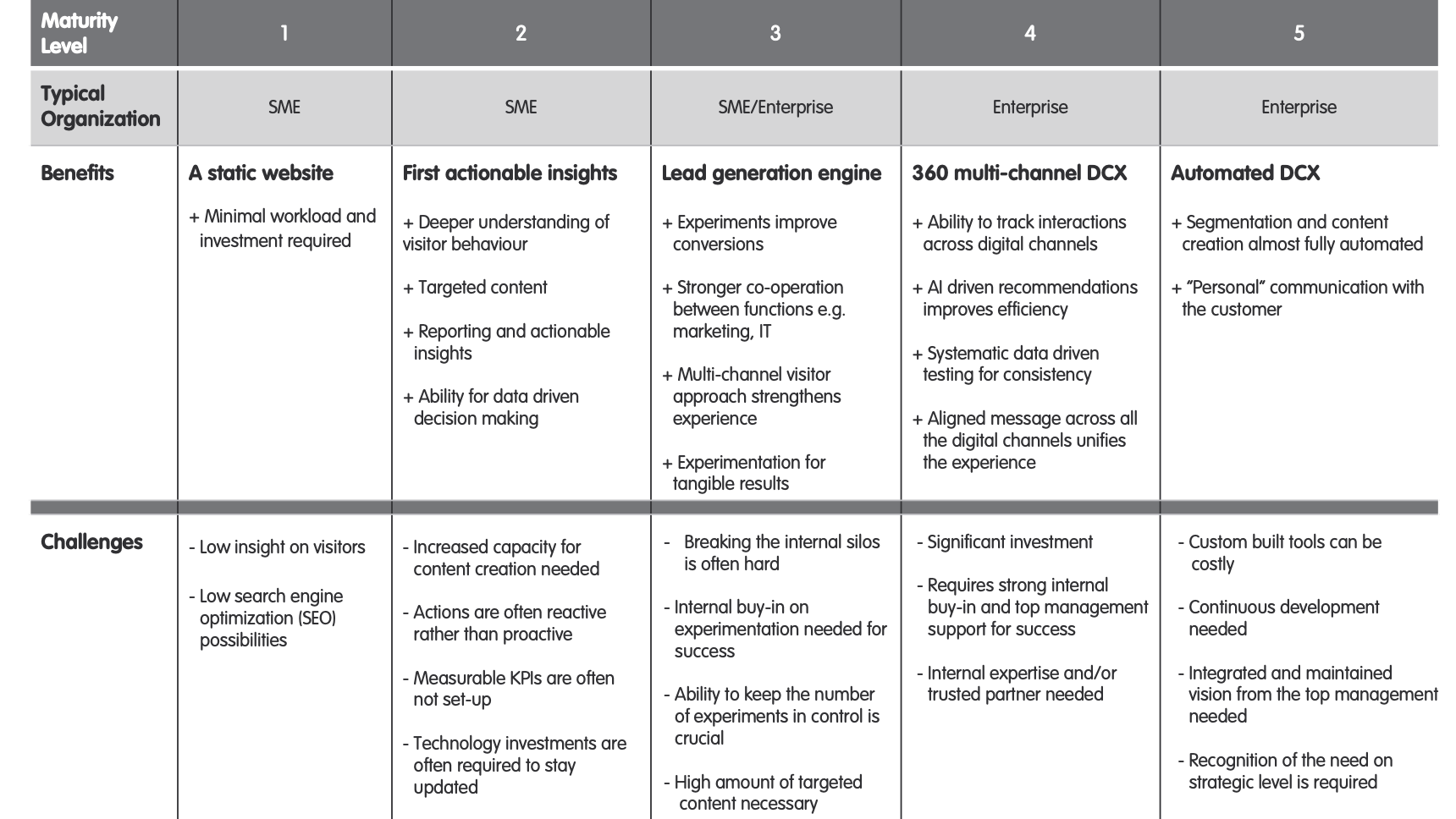
Most organizations, regardless of industry, want to assure a personalized customer experience. Yet, finding the right approach and investment level is not always easy.
To reach success, organizations need to understand their current digital marketing maturity; what opportunities and challenges does the current maturity level impose – and what investments are required, if the organization wants to jump to the next maturity level.
By understanding their digital maturity, organizations can improve the personalized experience, reduce unnecessary fees, as well as fully leverage the features of their technology of choice.
We at Siili have put together a short digital marketing maturity and personalization capabilities map based on lessons learned over 10 years of working with personalization. We also summarized our key learnings into 3 key points for you.
Personalization capabilities and different marketing maturity levels

Maturity level 1 – No personalization
There are some small and medium sized organizations, where having a "business card" type of a website is enough. Organizations at level 1 usually have a Content Management System (CMS) powered website, typically updated by a single person, often on a part-time basis. Some even prefer externalizing the website updates to an agency.
The content of the website is not targeted to specific target groups. Web analytics (if used) is used mainly to monitor the overall visibility and usage of the website, not to identify user segments or to understand user behaviour.
Maturity level 2 – Manual content production, increased understanding of visitors
Organizations at level 2 have realised that the website is a source for leads. They target their audience, do search engine optimized (SEO) keyword based content, and define some key performance indicators (KPIs) to monitor. The visitors of the website get more targeted experiences due to optimized content. The website has analytics enabled, such as Google Analytics. Some reports are created in the analytics platforms, but results are not consistently acted upon.
To get to the level 2 is quite simple. Most content management systems on the market offer modules or simple integrations with the analytics platforms. The hard part is defining the KPIs, tracking the correct events, or creating reports that provide actionable insights.
Level 2 requires a lot more work e.g. in following up on actions and in content creation, but can yield good results, compared to level 1. Consequently the "part-time website updater" approach of level 1 needs to be scrapped, and the build-up of a content creation team needs to begin.
This is usually the level where most organizations feel comfortable staying.
Maturity level 3 – Start experimenting
On level 3 there are organizations that want to improve conversions, with more targeted content. The easiest experiment is to set up A/B testing or multi-variant (A/B usually involves two variants, whereas multi-variant works with several) testing. Most analytics platforms provide some tools for the multi-variant testing. Hence, the platform usage becomes more critical. Organizations typically start using segmentation models that are concentrated on persona or geographic segmentation, since these are the easiest to use for marketing actions.
On level 3, experimentation is often sporadic and less coordinated across the different digital interactions and systems. Thus, it is critical to plan and organize experimentation aligned with e.g. campaign actions, personalization, reporting, and KPI follow-up. Experimentation activities create internal traction and communicates the value created.
One of the biggest challenges is the hight amount of content needed. Marketing and sales teams need to create targeted content for each defined segment, which further increases the workload.
Don't be afraid of experimentation. When done in a systematic way, experimentation can prove very efficient. Also, the results are typically easy to quantify. Focus on identifying the right segments. Here less is more – it is easier to create quality content for a smaller number of segments than trying to continuously create new content for many segments. On level 3, the crucial element is to prove that experimentation works, and that it is something worth investing in.
Maturity level 4 – Combine information from multiple digital channels
On level 4 are organizations with customer interactions in a multitude of digital channels, e.g. social media, websites, portals, mobile applications, and email. The challenge often becomes with channel integrations and enabling a unified customer 360 view. Personalization and segmentation become significantly more advanced as new demographic and behavioural segmentation models are created.
To get to level 4, it often requires significant investment, including breaking down internal silos, integration between marketing automation, CRM, technology, analytics, and other internal tools and systems. To take the leap to level 4, personalization should be a joint effort for IT, marketing, and sales.
Otherwise, initiatives are bound to fail due to internal resistance, siloed communication, or the lack of a unified vision.
Maturity level 5 – Fully automated personalization
On level 5, we currently only see a few selected companies, such as Netflix, Spotify, Amazon, and Zalando. These organizations tackle the forming and managing of segments via automation. The automation is using a consolidated data source combining data from all touchpoints, where users and the organization interact.
The challenges of maintaining and further developing such a system are very different to the challenges faced on the lower levels.
At level 5, content creators need to work on atomic parts of content and envision multiple scenarios in which the content they create might surface. The algorithms used for segmentation, recommendation and personalization need to be constantly fine-tuned, based on research. No ready-made products exist to support such activities. Hence, a significant effort of custom software development is needed.
We put together a list of 3 key points to keep in mind when developing personalization capabilities
- Have the courage to start. Do not be afraid to start with personalization, you do not need to have a lot of content in the beginning. Start by measuring the conversions e.g. with Google Analytics to track changes and learn about your visitors.
- Fully utilize existing tools. Many organizations have tools to support marketing automation actions. If you use your CRM heavily and get a lot of leads integrate your CRM to your CMS.
- Jumping to the next maturity level requires effort. Only level 1 is easy - But if you quantify your results, the extra effort is easier to justify and value created becomes measurable.
See also:
Wärtsilä Boosts Monthly Lead Gen by 3x with Sitefinity
https://www.progress.com/customers/w%C3%A4rtsil%C3%A4
Personalization of the Wärtsilä Digital Experience, Maud Bernard, Marketing Manager, Wärtsilä, Keynote from Progress Next 2018
https://youtu.be/lrUH3iYROyw
Sitefinity Digital Experience Platform
https://www.progress.com/solutions/digital-experience
Sitecore, How to organize and scale teams for digital maturity
https://www.sitecore.com/knowledge-center/getting-started/how-to-organize-and-scale-teams-for-digital-maturity
Acquia, The Digital Experience Platform for Drupal
https://www.acquia.com/
Written by:
Charlotta Välimäki, Key Account Manager
Kiril Jovchev, Senior Advisor, Software Architect
...
Read the parts 1–3 of this blog series:
Maximize customer lifetime value with data, analytics and machine learning
.png)
